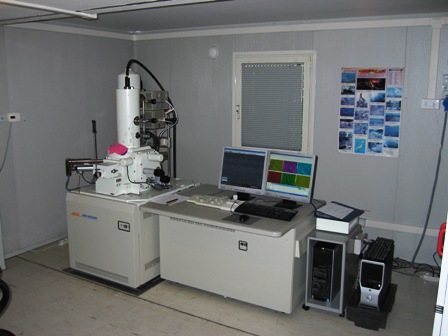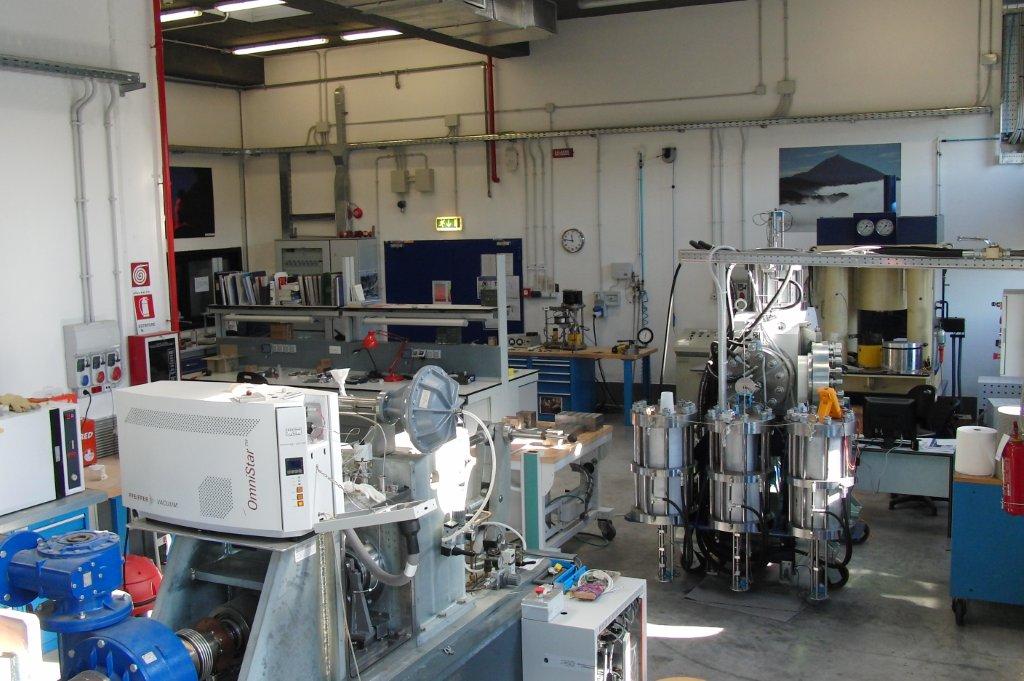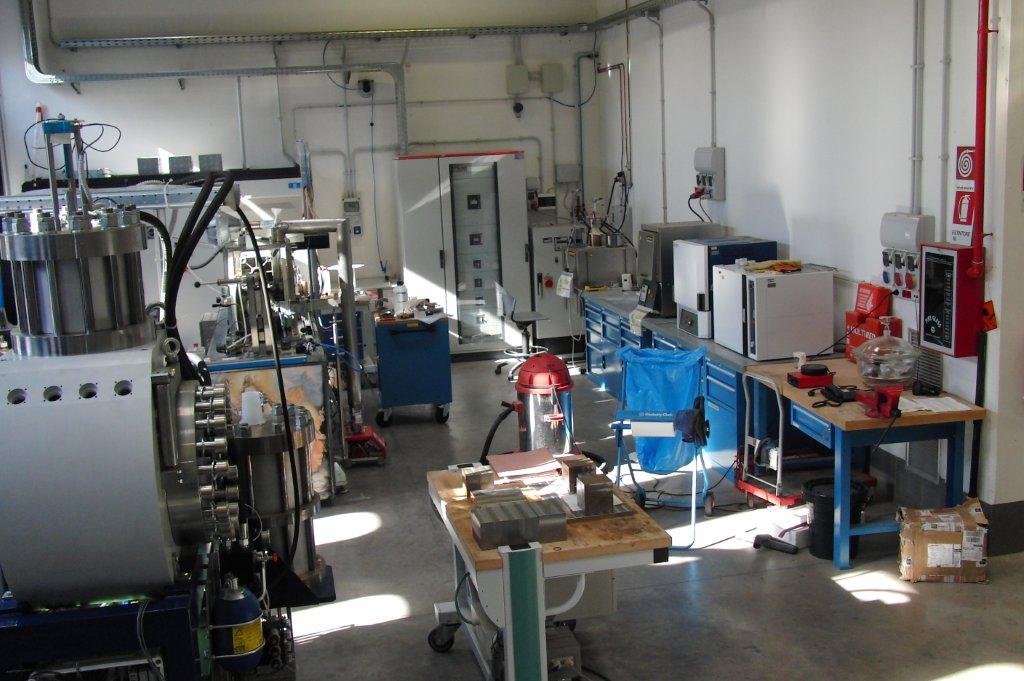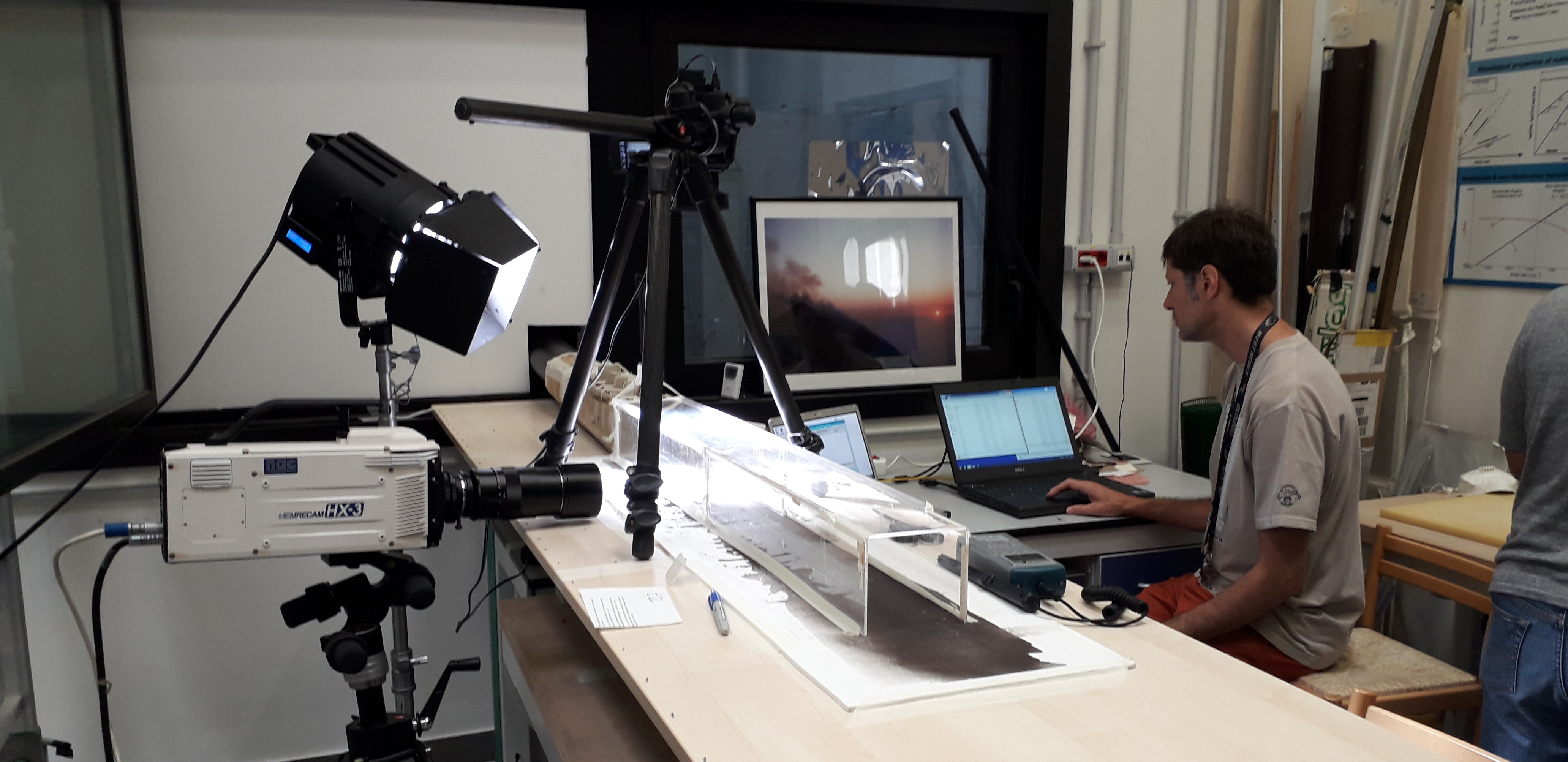
Microscopio elettronico ad emissione di campo

Laboratorio sperimentale

Laboratorio sperimentale
Laboratorio analogico: esperimento di risospensione della cenere nel tunnel del vento
Negli ultimi decenni il vertiginoso sviluppo delle conoscenze sulla tecnologia e scienza dei materiali ha reso possibile la costruzione di strumenti in grado di riprodurre le condizioni ambientali che controllano la dinamica dei processi chimico-fisici all'interno e sulla superficie terrestre. Fra questi processi, quelli relativi alla sismicità ed al magmatismo-vulcanismo sono di particolare rilevanza economica e sociale per il numero di vittime e l'entità di danni che provocano.
In questo ambito si è sviluppato presso la Sezione di Roma 1 dell’INGV il Laboratorio per le Alte Pressioni e Alte Temperature di Geofisica e Vulcanologia Sperimentali.
Lo studio sperimentale dei processi petrologici, geofisici e vulcanologici che avvengono all’interno e sulla superficie della Terra è l’obiettivo del Laboratorio che si è sviluppato in due settori principali, microanalitico e sperimentale. Il settore microanalitico è fondamentale per la caratterizzazione dei materiali. E’ equipaggiato con una microsonda elettronica per lo studio composizionale dei materiali geologici e sperimentali ed un microscopio elettronico ad emissione di campo destinato alle analisi tessiturali e morfometriche ad alta risoluzione. Il laboratorio è a disposizione di un gran numero di ricercatori sia dell’INGV che esterni.
Mediamente ogni anno vengono sviluppate 30 proposte di ricerca inerenti lo studio dei terremoti, eruzioni vulcaniche e le proprietà dei materiali. Il settore sperimentale è costituito da molti apparati che in parte sono stati anche sviluppati all’interno del laboratorio stesso. Le principali applicazioni riguardano (i) lo studio delle proprietà chimico-fisiche dei magmi, (ii) lo studio delle proprietà fisiche delle rocce e (iii) l’approccio analogico allo studio delle dinamiche eruttive e della frattura.
Nel laboratorio lavorano ricercatori e tecnologi sia italiani che stranieri e lo stesso rappresenta oggi un punto di riferimento internazionale della ricerca sperimentale nel settore geofisico e vulcanologico. Ogni anno vengono ospitati ricercatori provenienti da tutto il mondo, mentre l’attività formativa agli studenti provenienti da Università italiane e estere viene garantita attraverso stages, tesi di laurea e dottorati di ricerca. Lo sviluppo del Laboratorio per Alte Pressioni e Alte Temperature ha visto a partire dal 2004 la realizzazione di numerosi progetti sia nazionali che internazionali che vedono in alcuni casi il laboratorio stesso coinvolto anche come host institution.
The High Pressure-High Temperature Laboratory of the Istituto Nazionale di Geofisica e Vulcanologia of Rome (hereafter HPHT Lab) is a multidisciplinary facility originally founded in 2002.
The HPHT Lab includes three areas of investigation: 1) experimental testing of natural and synthetic materials; 2) microanalytical and physical analyses; 3) analog experiments. Volcanology, petrology, mineralogy, seismology, and rock physics are the main, broad areas of research at the HPHT Lab.
Concerning the experimental investigations, research in magma evolution and rheology, and on mantle petrology are carried out with high-pressure and high-temperature apparata, including furnaces, piston-cylinder, and multi-anvil devices, covering conditions from surface eruption of magma to middle mantle.
The frictional properties of faults and rocks are investigated under a wide range of slip rates and dynamics and under variable boundary conditions using unique rotary shear apparatus and large-scale bi-axial press. In addition, rock physics/mechanics studies, from rock permeability to fracturing and degassing can also be investigated with the above apparata and with more classical devices.
The analytical facilities include a Field-Emission Scanning Electron Microscope and an Electron Micro Probe Analyzer specifically tuned for natural rock analyses. Accessory to these are an helium pycnometer, particle size analyzer, sieves, and other basic instruments.
The analog investigations are carried out in a specific area where ad-hoc, temporary set-ups are developed. Analog materials are characterized using a rheometer, and the experiments are recorded and analyzed using a range of visual documentations, spanning from time-lapse cameras to high-definition and high-speed camcorders.
The analog laboratory focuses mostly on explosive volcanism and the related products and processes, including the formation and release of Taylor bubbles, pyroclast ejection during supersonic eruptions, and the sedimentation and aggregation of volcanic ash particles.
The HPHT Lab also hosts and develops new systems for the in-situ study of explosive volcanic eruptions by combining high-speed, high-definition imaging in the visible and thermal infrared wavelengths with acoustic recording. Investigated processes cover the ejection of volcanic ash and bombs, their settling and potential hazard, the sources of volcanic sound, and shifting styles of explosive volcanic activity.
The sharing of facilities and working space in between researchers with such a broad variety of backgrounds is a key component of the HPHT Lab, eventually leading to interdisciplinary exchange, facilitating the development of new projects, and ultimately promoting a stimulating research environment.
Annual Report 2023 | Annual Report 2022 | Annual Report 2021 | Annual Report 2020 | Annual Report 2019 | Annual Report 2018 | Annual Report 2017 | Annual Report 2016 |
TEAM
Stefano Aretusini | Contract Researcher
Emanuela Bagnato | Researcher
Riccardo Civico | Researcher
Chiara Cornelio | Contract Researcher
Gianfilippo De Astis | Senior Researcher
Elisabetta Del Bello | Researcher
Fabrizio Di Fiore | Contract Researcher
Giuseppe La Spina | Researcher
Valeria Misiti | Technologist
Manuela Nazzari | Researcher
Francesco Pennacchia | Contract Technician
Alessio Pontesilli | Contract Researcher
Giacomo Pozzi | Contract Researcher
Tullio Ricci | Researcher
Elena Spagnuolo | Researcher
Laura Spina | Researcher
Jacopo Taddeucci | Senior Researcher
Giancarlo Tamburello | Researcher
Piergiorgio Moschini | postdoc
FACILITIES
Multiple press 840 ton | Voggenreiter
Piston cylinder - 3/4” and 1” pressure plates | Voggenreiter
Multianvil - Walker type 6/8 | Voggenreiter
Quick Press - Piston Cylinder 3/4” and 1” pressure plates | Depth of the Earth
Bi-Tri-Axial Press (BRAVA) | RMP - INGV
Low to High Velocity Apparatus (SHIVA) | RMP - INGV
Electron microprobe equipped with 5 WDS and 1 EDS | JEOL JXA-8200
Field Emission Electron Microscope equipped with EBSD and STEM | Termofischer Scios 2 LV
Auto Carbon coater | JEOL JEC-530
Fine coater | JEOL JFC-2300HR
High and low temperature furnaces | Lenton
Impedance analyser | Solartron SI1260
Digital oscilloscope | Tektronix DPO4032
Wave generator | Agilent 33250A
H-Frame presses 10 ton | Enerpac
Precision balance | Sartorius
Optical and stereo microscopes | Leica DMRXP and Euromex
Ultra-high velocity, intensified, gated digital camera | Cordin 204-2
Stereomicroscopes | Leica MZ 9.5
Semiautomatic polisher | Buehler Minimet 1000
Power Supply | Agilent 6575A
Helium Picnometer | AccuPyc II 1340
Permeameter with double intensifier | Rock Physics
Rheometer MCR 301 Physica | Anton Paar
Vertical Furnace RHTV 120-300/18 | Nabertherm
High Temperature Furnace LHT 04/18 | Nabertherm
Cecchi data acquisition system | Applied Seismology
Rock drilling, cutting, and grinding equipment for samples preparation
Thermal High speed camera | FLIR SC 645
Welder PUK U3 | Lampert
Laser line generator | Edmund optics
Precision test sieves | Endecotts
Laser MGL-III, 532nm 200mW, PSU-III-LED/Unit | Changchun New Industries
Multi-Wavelength Analyser LUMiReader® PSA with Particle sizing according to ISO 13317
2 Polarized Free-field Microphones 40AN 1/2", Low Frequency (0.5Hz - 20kHz) | G.R.A.S.
Ext. Polarized Pressure Microphone 46DP-1 1/8", High Frequency (6.5Hz -140kHz) | G.R.A.S.
Vacuometro Pirani PVG-500
Petrographic microscope ECLIPSE E-50i POL | Nikon
Drying oven UF 75 | Memmert
4K digital camcorders | Sony
High Speed digital camcorder HX6 | NAC Memrecam
Shock-tube apparatus (Jet-Buster) | INGV
High speed digital camcorders | NAC 512 SC, Optronis CR600x2, NAC HX6, NAC HX3
Laser range finder | Vectronix VECTOR 21
Time Lapse Camera with 24-70 lens | Brinno TLC200 Pro
Precision Syringe Pumps | ISCO
Ash dispersal/settling apparatus (Ash-Buster) | INGV
Drone Matrice 300 RTK | DJI
Drone Mavic 2 Pro | DJI
Drone Phantom 4 RTK | DJI
Drone Mini 2 | DJI
Dual UV cameras 340 UVGE | Thorlabs
Laboratory sieve shaker Octagon 200 | Endecotts
Optical Profilometer Modus6ZS-3D | DeltaPIX
Triaxial ICP accelerometer | PCB PIezotronics
Two high frequency ICP pressure sensors | PCB PIezotronics
Three ceramic shear ICP accelerometers | PCB PIezotronics
Two 4-channel ICP sensor signal conditioners | PCB Piezonotrics
MEERA biaxial direct shear apparatus | INGV/TEES
High-temperature, vacuum, inert, and reactive gas furnace
Microdriller for experimental glasses | ARNOLD 561/01
Mortar grinder for experimental glasses | PULVERISETTE 23 FRITSCH
SKO-D XL Orbital Shaker | SKO
Centrifuge Neya 8 Basic | NEYA
DANTE I Carbolite Gero | Verder Scientific
SKATE (Setup for the Kinematic Acquisition of Explosive Eruptions) | INGV/T.E.E.S.
FBG interrogator DM-8120 | SENTEA
PROGETTI DI RICERCA
- Piano Nazionale di Riprese e Resilienza - Next Generation Europe Program: Monitoring Earth's Evolution and Tectonics Project MEET | WP 3 Integrated Laboratories for the Geosciences and the Environment ILGE | WP leaders P. Scarlato - F. Funiciello
- MIUR Progetto PRIN 2017 | Scales of solidification in magmas: applications to volcanic eruptions, silicate melts, glasses, glass- ceramics | P.I. M. Carroll
- MIUR Progetto PRIN 2022 | PROVES: an integrated PetRO-Volcanological monitoring approach applied to Mt. Etna and Stromboli - 2022N4FBAA | P.I. M. Masotta
- MIUR PON | GRINT | P.I. G. Puglisi
- European research project | EXCITE 2 ‘Electron and X-ray microscopy Community for structural and chemical Imaging Techniques for Earth materials’ | P.I. Utrecht University
- European research project | Marie Sklodowska-Curie European Training Network IMPROVE, Innovative Multi-disciplinary European Research training network on VolcanoEs | P.I. P. Papale
- INGV "Ricerca libera" Project | Magma dynamics triggering the 3 July and 28 August 2019 paroxysms at Stromboli volcano: A comparative approach based on the ascent rates, timescales and P-T-H2O paths of magma | P.I. P. Scarlato
- INGV "Ricerca libera" Project | FRAMMENTI, FRAgmentation of Mafic Magmas: ExteNt and TIming | P.I. J. Taddeucci
- INGV “Ricerca libera” Project | ROUGHER, expeRimental Observations aboUt irreGular cHannel gEometRies| P.I. L. Spina
- INGV Departmental Strategic Projects | UNO - UNderstanding the Ordinary to forecast the extraordinary: An integrated approach for studying and interpreting the explosive activity at Stromboli volcano | P.I. P. Scarlato
- ASI-INAF Project | “Esopianeti” | P.I. G. De Astis
- ERC Syn Fear | Fault activation and Earthquake Rupture | P.I. D. Giardini, F. Amman, M. Cocco, S. Wiemer
- Marie Sklodowska-Curie Individual Fellowship | “Experiments, Numerical moDelling and field observations of basaltic maGmA fragMEntation (ENDGAME)”| P.I. J. Taddeucci, G. La Spina
- INGV “Pianeta Dinamico” Project | DYNAMO DYNAmics of eruptive phenoMena at basaltic vOlcanoes | P.I. L. Zuccarello
- INGV “Pianeta Dinamico” Project | CAVEAT | P.I. M. Palano
- IRGIE Inventario delle Risorse Geotermiche delle Isole Eolie. stima del potenziale e proposte di utilizzo | P.I. M. Procesi
- INGV “Pianeta Dinamico” Project | Sibilla | P.I. A. Pignatelli





